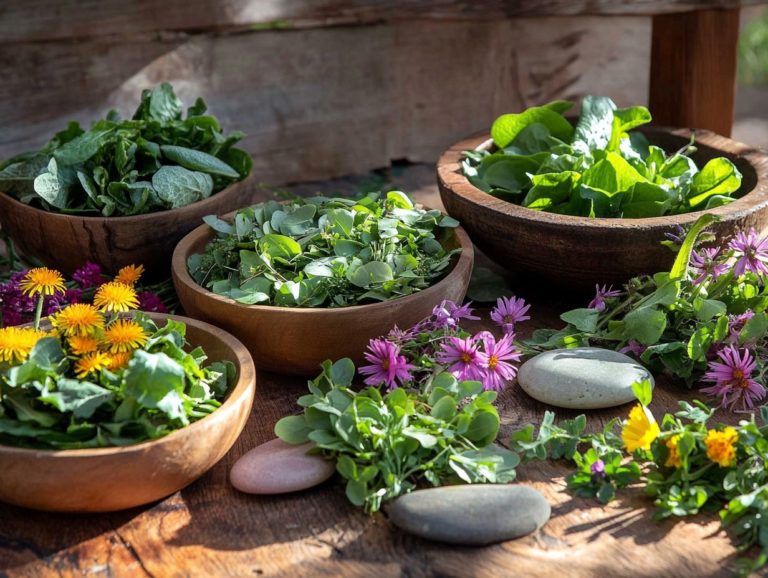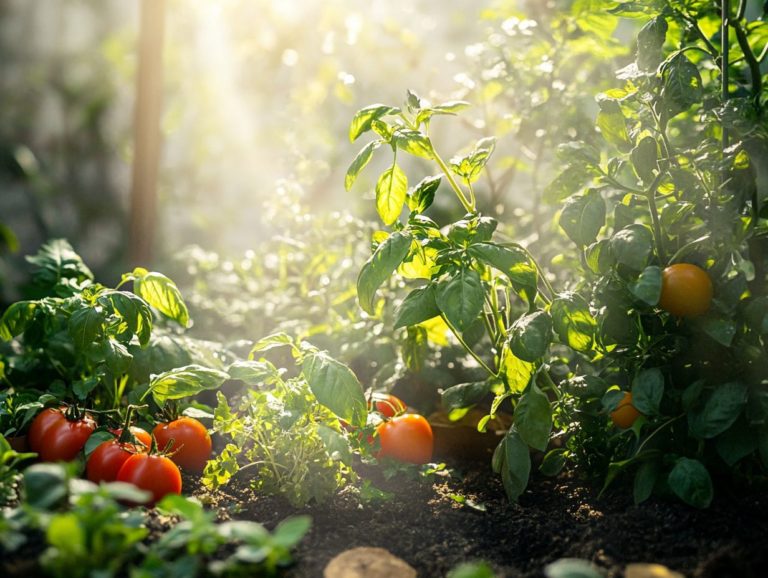How to Educate Kids About Foraging Edibles
Teaching children about foraging is not merely an enjoyable outdoor pursuit. It presents a wealth of benefits for their growth and development, especially through engaging in activities like identifying plants and learning about herbs.
From sharpening their observation skills to deepening their connection with the natural world, foraging can significantly enrich their lives in various ways.
This article delves into essential topics such as identifying safe and edible plants, ensuring foraging safety, and engaging children through hands-on activities. It also offers innovative strategies to incorporate foraging into your family’s everyday routine.
Discover the joys and educational value of foraging for the next generation. Inspire a love for nature that will last a lifetime!
Contents
- Key Takeaways:
- The Importance of Teaching Kids About Foraging
- Identifying Safe and Edible Plants
- Teaching Foraging Safety
- Fun and Educational Foraging Activities for Kids
- Incorporating Foraging into Daily Life
- Frequently Asked Questions
- What is foraging, and why should kids learn about it?
- What are some safety precautions to take when foraging with kids?
- How can I make foraging fun and engaging for kids?
- What are some common misconceptions about foraging that kids may have?
- How can I incorporate foraging into my child’s diet?
- What are some additional resources for teaching kids about foraging?
Key Takeaways:

- Foraging teaches kids about nature and promotes their physical, mental, and emotional development, especially through fun outdoor activities.
- It is crucial to educate children on how to identify safe and edible plants and to follow basic foraging protocols to avoid potential risks.
- Fun and engaging foraging activities can make learning enjoyable and hands-on for children, making it easier to incorporate into daily family activities.
The Importance of Teaching Kids About Foraging
Teaching children about foraging goes beyond just identifying wild edibles; it involves how to teach foraging techniques to kids, cultivating a deep connection with nature, honing outdoor skills, and instilling healthy eating habits.
Foraging ignites curiosity and fosters engagement. Kids explore their surroundings while discovering diverse and nutritious plants in their local ecosystem.
This practice opens doors to hands-on learning. It can seamlessly integrate into a variety of outdoor activities, transforming each experience into a delightful and educational adventure.
Such experiences nurture their appreciation for nature and sustainability.
Benefits for Children’s Development and Learning Herbs
Foraging offers a wealth of benefits for your child s development. It enhances their outdoor skills and knowledge of nutritious plants while fostering creativity and promoting physical activity.
When they engage in foraging, children sharpen their sensory awareness. They learn to identify various edible plants, from the vibrant yellow dandelion to the sweet, juicy blackberry.
This hands-on experience sparks a deeper curiosity about the natural world and helps them understand ecological relationships.
The act of gathering wild plants involves physical movement. This encourages your kids to traverse different terrains, strengthening their bodies and improving coordination.
Foraging tips can serve as a delightful guide for your family. Transform local parks or backyards into mini-adventures brimming with discovery.
Identifying Safe and Edible Plants
Identifying safe and edible plants is an essential skill for any forager. This knowledge allows you to fully appreciate nature while steering clear of toxic plants that could jeopardize your health.
Embracing this expertise enhances your foraging experience. It enables you to harness the rich, natural resources around you with confidence.
Basic Guidelines for Foraging

Adhering to fundamental guidelines for foraging guarantees a thrilling and safe adventure! This includes mastering plant harvesting techniques and ethical harvesting practices.
These guidelines prioritize your safety while cultivating a deep respect for the environment. Familiarize yourself with local flora to accurately identify edible species and distinguish them from toxic look-alikes.
Sustainable foraging is all about taking only what you need. This allows plant populations to thrive and regenerate naturally over time. Respect private lands and seek permission before foraging there.
Understanding local laws and regulations helps you avoid legal issues, such as harvesting protected species or exceeding permitted limits. With these practices in mind, relish nature’s bounty while ensuring its preservation for future generations.
Teaching Foraging Safety
Teaching foraging safety is essential for enabling both children and adults to explore the outdoors with confidence, while avoiding the dangers of poisonous plants and unsafe harvesting methods. Learning how to use foraging to educate others can enhance this experience.
Precautions and Protocols
Establishing precautions and protocols for foraging is crucial for ensuring both safety and enjoyment, especially when children are involved in discovering safe edibles.
To enhance your foraging experience, familiarize yourself with detailed safety protocols. This includes conducting thorough research on local plant species, seeking personal stories from reputable foraging guides, and using field guides or mobile applications that assist in proper identification.
It’s crucial to adopt the habit of harvesting only from areas free of pesticides and pollutants. Community foraging events present excellent opportunities for learning. They often feature knowledgeable local experts who share invaluable insights and techniques. These gatherings foster an engaging atmosphere for questions and discussions on best practices for recognizing edible plants.
This way, novice and seasoned foragers can prioritize safety and responsibility in their explorations, making the experience rewarding for everyone involved.
Fun and Educational Foraging Activities for Kids
Engaging in fun and educational foraging activities for kids can elevate a simple hike into an enriching adventure. This approach fosters a deep appreciation for nature while equipping them with valuable, practical skills for life.
Engaging and Hands-On Learning

Engaging in hands-on learning experiences in foraging captures interest and deepens understanding of wild edibles and the significance of sustainable practices.
By joining guided foraging walks, you and your family can immerse yourselves in the natural world while gaining invaluable skills for identifying safe and nutritious plants. Local community foraging organizations offer workshops that enhance this experience, providing essential tips and techniques.
These events often feature expert-led demonstrations that emphasize the ethical aspects of harvesting wild foods, ensuring a respectful relationship with your environment. Community gatherings like potluck dinners showcasing foraged ingredients create a sense of shared exploration, inspiring everyone to embrace the benefits of foraging within a supportive network.
Incorporating Foraging into Daily Life
Incorporating foraging into your daily life can elevate family routines, encouraging healthy eating while nurturing a deeper connection with nature through the beauty of seasonal living practices and foraging resources.
Get ready to explore the great outdoors and discover the amazing world of foraging today!
Ways to Integrate Foraging into Family Activities
Integrating foraging into family activities offers you the chance to create unforgettable experiences while teaching your children valuable skills about wild edibles and healthy living.
Start exciting adventures with simple weekend outings to local parks, where your family can explore nearby trails and learn to identify edible plants like dandelions or wild garlic. Enroll in guided foraging classes to broaden your knowledge and nurture a sense of community among families who share a love for the outdoors!
In these enriching environments, your children will flourish. They will gain confidence while exploring the joys of gathering their own food and connecting deeply with nature. At home, they can create simple recipes with their freshly harvested ingredients. This not only deepens their appreciation for healthy meals but also turns everyday cooking into an exhilarating culinary adventure!
Frequently Asked Questions
What is foraging, and why should kids learn about it?

Foraging is the act of searching for and gathering wild, edible plants, mushrooms, and other natural foods. It is essential for kids to learn about foraging because it teaches them skills like taking care of themselves, valuing the environment, and appreciating nature.
What are some safety precautions to take when foraging with kids?
Always supervise children when foraging. Ensure they understand to only pick and eat plants that have been identified as safe. Additionally, teach them how to educate others about foraging and to never eat anything they find in the wild without an adult’s permission and guidance.
How can I make foraging fun and engaging for kids?
Make it a game! Create a scavenger hunt for edible plants or have a competition to see who can find the most varieties of wild foods. If you’re new to this, check out how to start foraging for wild edibles. You can also incorporate art and creativity by having the kids make a nature journal or create a meal using the foraged ingredients!
What are some common misconceptions about foraging that kids may have?
One common misconception is that all plants in the wild are safe to eat. Kids need to understand the importance of proper identification and adult supervision when foraging. Another misconception is that foraging is harmful to the environment. In reality, responsible foraging can benefit the environment by controlling invasive species like Himalayan Balsam and promoting biodiversity.
How can I incorporate foraging into my child’s diet?
Start by introducing them to familiar and safe plants, such as blackberries or wild herbs like plantain and purslane, and incorporating them into meals or snacks. You can also experiment with new herbal recipes and dishes using foraged ingredients like stinging nettle and cattail. For more guidance, refer to this resource on how to forage edible plants safely. Just make sure to wash and prepare the plants properly before consuming.
What are some additional resources for teaching kids about foraging?
There are many great books, websites, and classes available that can help educate kids about foraging. To enhance their learning, check out resources such as how to teach kids about foraging. Look for materials specifically geared towards children and always double-check the information before sharing it with your child. Notable figures in this field include Josh Fecteau, Steve Brill, and Kathie Lapcevic. You can also explore platforms like PBS and Health Starts in the Kitchen for more information on edible flowers and elderflowers.






